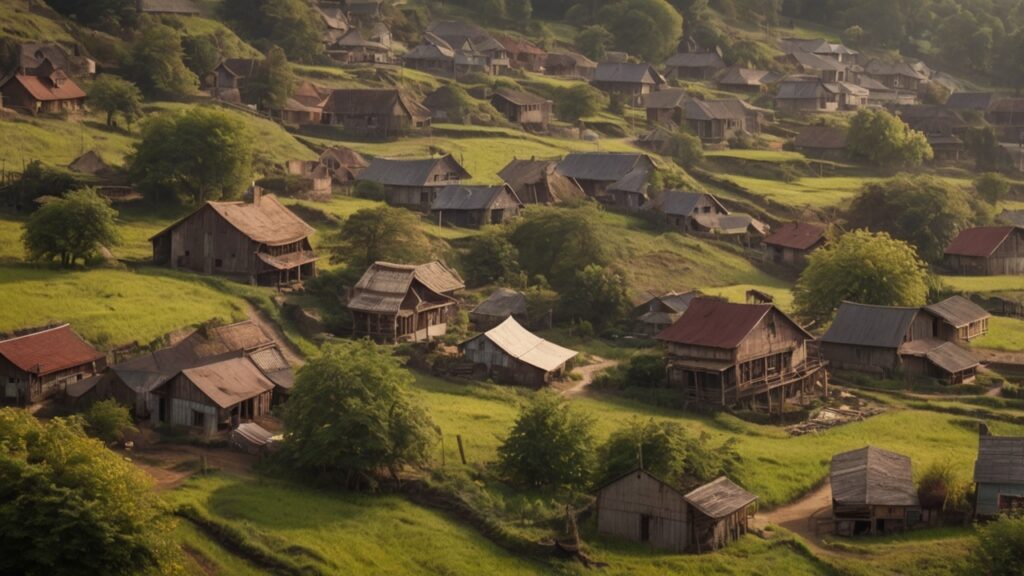Cost of living is a crucial factor when choosing where to settle. Cities offer modern conveniences and job opportunities, while villages provide peace and affordability. But which is truly more cost-effective? Let’s break it down.
1. Housing Costs
Rent & Property Prices
- Urban areas have skyrocketing rental prices.
- Rural properties are cheaper, but availability may be limited.
- Homeownership is more accessible in villages.
Utilities & Maintenance
- City homes have higher electricity and water costs.
- Village homes may rely on wells and solar energy, reducing bills.

2. Transportation Expenses
Public Transit
- Cities offer extensive public transport networks.
- Villages lack such options, making car ownership essential.
Fuel & Car Maintenance
- Gas prices fluctuate, but urban traffic increases consumption.
- Rural roads cause more wear and tear on vehicles.
3. Food & Grocery Prices
Supermarket Costs
- Cities have diverse food choices but higher prices.
- Villages rely on locally sourced goods, often cheaper.
Local Market Prices
- Farmers’ markets in villages provide fresh, affordable produce.
- Urban stores charge a premium for convenience.
4. Healthcare Services
Availability
- Cities have advanced hospitals and specialists.
- Villages may lack immediate medical attention.
Cost Comparison

- Urban healthcare is expensive but efficient.
- Rural clinics are cheaper but may offer limited services.
5. Education & Schooling
Public vs. Private
- Cities provide access to high-quality education.
- Rural areas have fewer schooling options.
Accessibility
- Commuting to schools in villages may be difficult.
- Urban schools often offer extracurricular activities.
6. Employment & Income Opportunities

Salary Differences
- City jobs pay more but come with higher expenses.
- Rural jobs pay less but cost of living is lower.
Job Availability
- Cities have a wider range of job opportunities.
- Villages offer limited career options.
7. Entertainment & Leisure
Cost of Dining Out
- City restaurants charge higher due to demand.
- Village eateries are more budget-friendly.
Recreational Activities
- Urban entertainment options are diverse but costly.
- Rural areas offer free outdoor activities like hiking and fishing.
8. Safety & Security

Crime Rates
- Urban crime rates are higher.
- Villages tend to be safer with tight-knit communities.
Emergency Services
- Cities have faster emergency response times.
- Rural areas may experience delays in services.
9. Environmental Factors
Pollution Levels
- Cities have air and noise pollution.
- Villages offer cleaner, fresher air.
Access to Green Spaces
- Urban parks exist but are crowded.
- Rural living provides vast open spaces.
10. Social & Community Life

Neighbor Interaction
- City life is fast-paced with minimal interaction.
- Villages foster stronger community bonds.
Cultural Differences
- Cities are diverse, offering cultural variety.
- Rural areas hold traditional values.
11. Internet & Digital Connectivity
Speed & Availability
- Urban areas have high-speed internet.
- Rural internet can be slower and less reliable.
Work-from-Home Feasibility
- Cities are better suited for remote work.
- Rural connectivity issues may pose challenges.
12. Overall Quality of Life
Stress Levels
- City life is fast-paced and stressful.
- Rural living promotes relaxation and well-being.
Mental Well-being
- Access to mental health services is better in cities.
- Village life offers natural stress relief.
13. Financial Savings Potential

Retirement Savings
- Villages provide a better environment for retirees.
- Cities require more financial planning for retirement.
Investment Opportunities
- Urban areas have better investment potential.
- Rural real estate is an affordable investment option.
14. Common Misconceptions
- Cities aren’t always better for careers.
- Villages aren’t necessarily isolating.
- Cost of living isn’t just about money—it’s about lifestyle.
15. Final Verdict: Which is More Affordable?
If saving money is the priority, villages win.
For career growth and opportunities, cities are better.
The best choice depends on individual needs and lifestyle.

FAQs
1. Is living in a village always cheaper than a city?
Not always. While housing and food may be cheaper, transportation and limited job opportunities can offset savings.
2. Do cities offer better healthcare than villages?
Yes, cities provide better medical facilities, but at a higher cost.
3. Is it easier to start a business in a village or a city?
Cities offer more customers, but rural areas provide niche opportunities with lower competition.
4. Can you work remotely from a village?
Yes, but internet speed and reliability can be a challenge.
5. Is village life safer than city life?
Generally, yes, due to lower crime rates and close-knit communities.
6. Which is better for raising children, a city or a village?
Villages offer safer environments, but cities provide better educational opportunities.

Java Burn is 100% all-natural…
Vegetarian…
Non-GMO…
Gluten free…
It has no added fillers, preservatives, artificial colors or stimulants of any kind.
Every packet of Java Burn is manufactured right here in the USA in our state of the art FDA approved and GMP (good manufacturing practices) certified facility under the most sterile, strict and precise standards.



